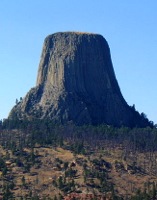Difference between revisions of "Intrusion"
(Created page with 'File:lighterstill.jpgframe|<center>A well-known example of an intrusion is [http://en.wikipedia.org/wiki/Devils_Tower Devils Tower</center>] ==Or...') |
m (Text replacement - "http://" to "https://") |
||
| (One intermediate revision by the same user not shown) | |||
| Line 1: | Line 1: | ||
| − | [[File:lighterstill.jpg]][[File:DevilsTower200.jpg|frame|<center>A well-known example of an intrusion is [ | + | [[File:lighterstill.jpg]][[File:DevilsTower200.jpg|frame|<center>A well-known example of an intrusion is [https://en.wikipedia.org/wiki/Devils_Tower Devils Tower</center>]]] |
==Origin== | ==Origin== | ||
| − | [ | + | [https://nordan.daynal.org/wiki/index.php?title=English#ca._1100-1500_.09THE_MIDDLE_ENGLISH_PERIOD Middle English], from Anglo-French, from Medieval Latin ''intrusion''-, ''intrusio'', from [[Latin]] ''intrudere'' |
| − | *[ | + | *[https://en.wikipedia.org/wiki/15th_century 15th Century] |
==Definitions== | ==Definitions== | ||
*1: the [[act]] of wrongfully entering upon, seizing, or taking [[possession]] of the [[property]] of another | *1: the [[act]] of wrongfully entering upon, seizing, or taking [[possession]] of the [[property]] of another | ||
| − | *2: the forcible entry of molten rock or [ | + | *2: the forcible entry of molten rock or [https://en.wikipedia.org/wiki/Magma magma] into or between other rock formations |
==Description== | ==Description== | ||
| − | An '''intrusion''' is liquid rock that forms under [[Earth]]'s [[surface]]. [ | + | An '''intrusion''' is liquid rock that forms under [[Earth]]'s [[surface]]. [https://en.wikipedia.org/wiki/Magma Magma] from under the surface is slowly pushed up from deep within the earth into any cracks or spaces it can find, sometimes pushing existing country rock out of the way, a [[process]] that can take millions of years. As the rock slowly cools into a solid, the different parts of the magma crystallize into [[minerals]]. Many [[mountain]] ranges, such as the [https://en.wikipedia.org/wiki/Sierra_Nevada_(U.S.) Sierra Nevada] in California, are formed mostly by intrusive rock, large granite (or related rock) formations. |
| − | Intrusions are one of the two ways [ | + | Intrusions are one of the two ways [https://en.wikipedia.org/wiki/Igneous_rock igneous rock] can form; the other is extrusive, that is, a [https://en.wikipedia.org/wiki/Types_of_volcanic_eruptions volcanic eruption] or similar event. Technically speaking, an intrusion is any formation of intrusive igneous rock; rock formed from magma that cools and solidifies within the [https://en.wikipedia.org/wiki/Earth's_crust crust of the planet]. In contrast, an extrusion consists of [https://en.wikipedia.org/wiki/Extrusive_(geology) extrusive rock]; rock formed above the surface of the crust. |
| − | Intrusions vary widely, from mountain-range-sized [ | + | Intrusions vary widely, from mountain-range-sized [https://en.wikipedia.org/wiki/Batholith batholiths] to thin veinlike fracture fillings of [https://en.wikipedia.org/wiki/Aplite aplite] or [https://en.wikipedia.org/wiki/Pegmatite pegmatite]. When exposed by [[erosion]], these cores called batholiths may occupy huge areas of Earth's surface. Large bodies of magma that solidify underground before they reach the surface of the crust are called [https://en.wikipedia.org/wiki/Pluton plutons]. |
| − | Coarse-grained intrusive igneous rocks that form at depth within the earth are called [ | + | Coarse-grained intrusive igneous rocks that form at depth within the earth are called [https://en.wikipedia.org/wiki/Abyssal abyssal] while those that form near the surface are called [https://en.wikipedia.org/wiki/Hypabyssal hypabyssal]. Intrusive structures are often [[classified]] according to whether or not they are parallel to the [https://en.wikipedia.org/wiki/Stratum bedding planes] or [https://en.wikipedia.org/wiki/Foliation_(geology) foliation] of the country rock: if the intrusion is parallel the body is concordant, otherwise it is discordant. |
[[Category: Earth Science]] | [[Category: Earth Science]] | ||
Latest revision as of 01:39, 13 December 2020

Origin
Middle English, from Anglo-French, from Medieval Latin intrusion-, intrusio, from Latin intrudere
Definitions
- 1: the act of wrongfully entering upon, seizing, or taking possession of the property of another
- 2: the forcible entry of molten rock or magma into or between other rock formations
Description
An intrusion is liquid rock that forms under Earth's surface. Magma from under the surface is slowly pushed up from deep within the earth into any cracks or spaces it can find, sometimes pushing existing country rock out of the way, a process that can take millions of years. As the rock slowly cools into a solid, the different parts of the magma crystallize into minerals. Many mountain ranges, such as the Sierra Nevada in California, are formed mostly by intrusive rock, large granite (or related rock) formations.
Intrusions are one of the two ways igneous rock can form; the other is extrusive, that is, a volcanic eruption or similar event. Technically speaking, an intrusion is any formation of intrusive igneous rock; rock formed from magma that cools and solidifies within the crust of the planet. In contrast, an extrusion consists of extrusive rock; rock formed above the surface of the crust.
Intrusions vary widely, from mountain-range-sized batholiths to thin veinlike fracture fillings of aplite or pegmatite. When exposed by erosion, these cores called batholiths may occupy huge areas of Earth's surface. Large bodies of magma that solidify underground before they reach the surface of the crust are called plutons.
Coarse-grained intrusive igneous rocks that form at depth within the earth are called abyssal while those that form near the surface are called hypabyssal. Intrusive structures are often classified according to whether or not they are parallel to the bedding planes or foliation of the country rock: if the intrusion is parallel the body is concordant, otherwise it is discordant.